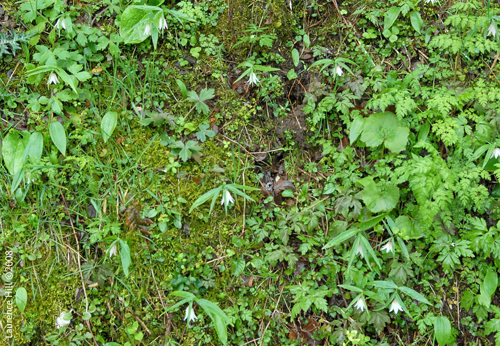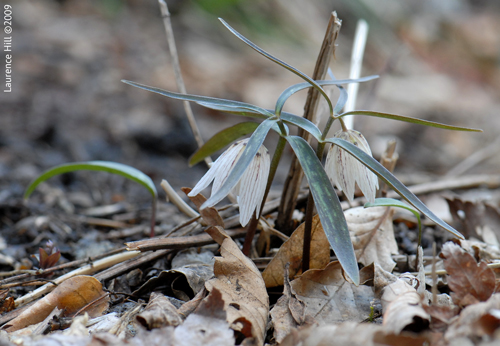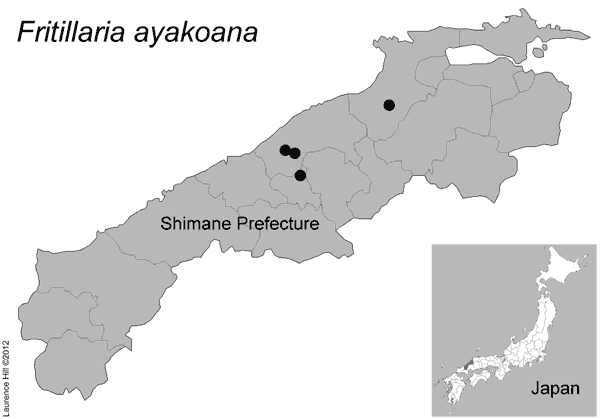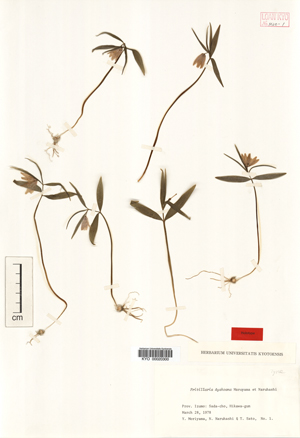Fritillaria ayakoana
Fritillaria ayakoana has one of the most limited ranges of all the Japanese endemic Fritillaria and is known from only two areas of Shimane Prefecture in southern Honshu. It was discovered in 1974 by Ayako Maruyama, the wife of a local botanist, in Sada-cho near Izumo-shi in the north of the prefecture. The location is about 50 km north of F. amabilis in neighbouring Hiroshima prefecture. In 1979 Iwao Maruyama and Naohiro Naruhashi described F. ayakoana as a new species as it differed from F. amabilis in its flower shape and nectaries. F. amabilis has a narrow-campanulate flower and the tepal apex is rounded. In contrast F. ayakoana has a more open cup-campanulate flower with a pointed tepal apex. This is only evident in the middle of its flowering period and otherwise appears much closer to F. amabilis. The difference in the nectaries is therefore the key diagnostic character. In F. amabilis the nectary is small and circular at the base of the tepal while in F. ayakoana it is about 2 mm from the base of the tepal and 6-11 mm long.
The type locality for F. ayakoana has been lost through the construction of a new road but two small populations remain in Sada-cho. Both are located in residential areas about 2 or 3 km apart but with less than 100 flowering plants between them. In recent years a second cluster south of Sada-cho has been found from Kawamoto to Ohda with one population located as recently as 2007. At Kawamoto the population is actively managed and protected by the local community. Each year in March special weekend viewing days and lectures are organised for wildflower enthusiasts. The total size of the Kawamoto population is probably equal to the total population from all other known sites.

Near to the original type location

Mt. Ooetakayama
The Chūgoku region in south-west Honshu is characterized by two distinct climatic zones. North of the Chūgoku Mountains most of the land is formed by irregular hills with the exception of the rice fields of the Izumo plain. Facing the Sea of Japan the weather is colder and wetter, often with snow extending into early spring. The area is known as San-in or ‘In the shade of the mountain’. To the south of the Chūgoku Mountains the land slopes away to the Seto Inland Sea. Known as San-yo or ‘Sunny side of the mountain’ the land is protected from the north by the mountains and to the south by the island of Shikoku. The weather here is milder and calmer with less rain.
Three Japanese endemic Fritillaria are found within the Chūgoku region and all occurring in different biogeographic zones. All three also have 11 and not usual 12 chromosomes found in most Fritillaria. To the south-east of the mountains and at lower elevations are pockets of F. japonica. Usually at higher elevations but still to the south of the mountains and running throughout the region is F. amabilis. To the north of the mountains between the Gonokawa River in the west and the Izumo Plain in the east F. ayakoana can be found from near sea level up to almost 800 m. Most F. ayakoana grow on land that has been altered by human activity except for several small pockets on Mt Ooetakoyama. Growing in bamboo scrub below deciduous tree this is possibly all that remains of its natural habitat. A field census on Mt Ooetakoyama in 2008 recorded just 26 flowering plants across four locations.

Fritillaria ayakoana Maruyama & Naruhashi, the Journal of Geobotany, 26 (4): 92(1979).
Japanese Name: イ ズモコバイモ (Izumo-kobaimo)
Description
Bulb 10-15 mm in diameter, white twin scaled covered in a thin translucent tunic. Stem slender, smooth, height 10-15 cm topped by a whorl of 3 leaves with 2 opposite leaves 1-20 mm below. Leaves green, occasionally red, all narrow lanceolate or linear, opposite pair 40-80 x 7-15 mm, whorled leaves 30-65 x 3-10 mm. Pedicel 6-13 mm long, emerging from the middle of the whorl of leaves, green, grey or dark pink, often wrinkled. Flowers nodding cup-campanulate, white with pink or purple-brown longitudinal veining. Tepals entire up to 29 mm long, inner 9 mm, outer 8mm wide, apex pointed. Nectaries about 2 mm from the base of the tepal, a green dot with pale yellow streak towards the apex, 6-11 mm long. Filament thin, papillose up to 11 mm long. Anthers narrow oblong to 6 mm long, pale yellow-brown. Style papillose, white, sometimes with pink dots, to 10 mm long, apex divided 1-1.5 mm. Capsule green, nodding, pyramidal with a concave base, valvate, 10-16 mm long, 7-11 mm wide.
Seed ovoid, not winged with an elaiosome.
Chromosome Number: 2n = 22.
Habitat: below deciduous tree, with Asarum asperum F. Maek., Corydalis lineariloba Siebold & Zucc., Epimedium sempervirens Nakai. & F. Maek., 50-800 m.
Flowering period: March to early April.

Type: Japan, Honshu, Shimane, Hikawa-gun, Sada-cho. I Maruyama, N Naruhashi et. T Sato No. 1, 28 March 1978 (KYO!).
Shimane Red Data Book 2004: Extermination fear I type CR+EN
Cultivation
Although Fritillaria ayakoana is rare in cultivation it is not difficult to grow. Use equal parts of composted bark, leaf mould and fine grit in terracotta pots. Plunge in an open frame away from direct sunlight. The bulbs must be kept moist at all times. As F. ayakoana flowers in late winter hand pollinate to encourage seed set. Seed output recorded in cultivation from hand pollinated plants was in the ranges 10 - 40 seeds per capsule (average 25 seeds). The output from Mt Ooetakoyama plants was only in the range 10 - 13 seeds per capsule.
Laurence Hill ©2012
![]()


